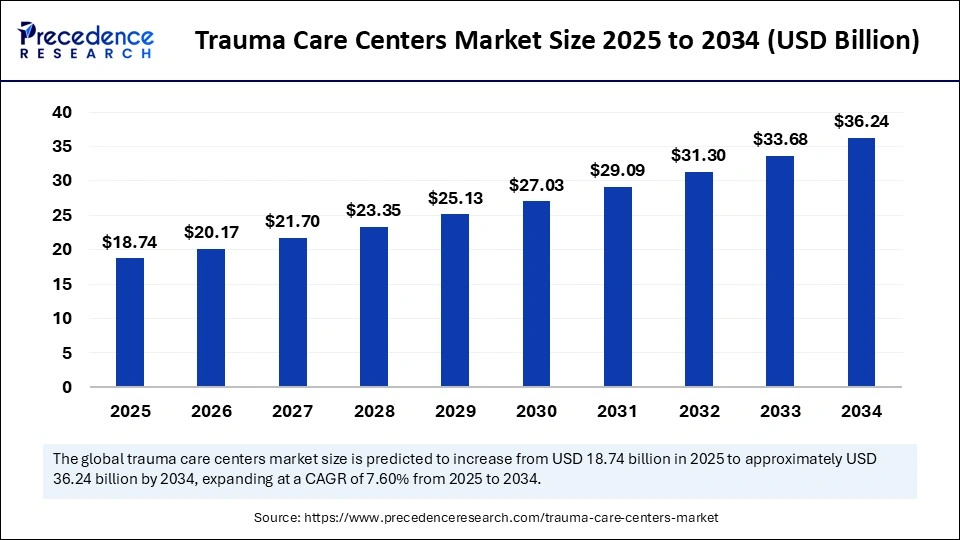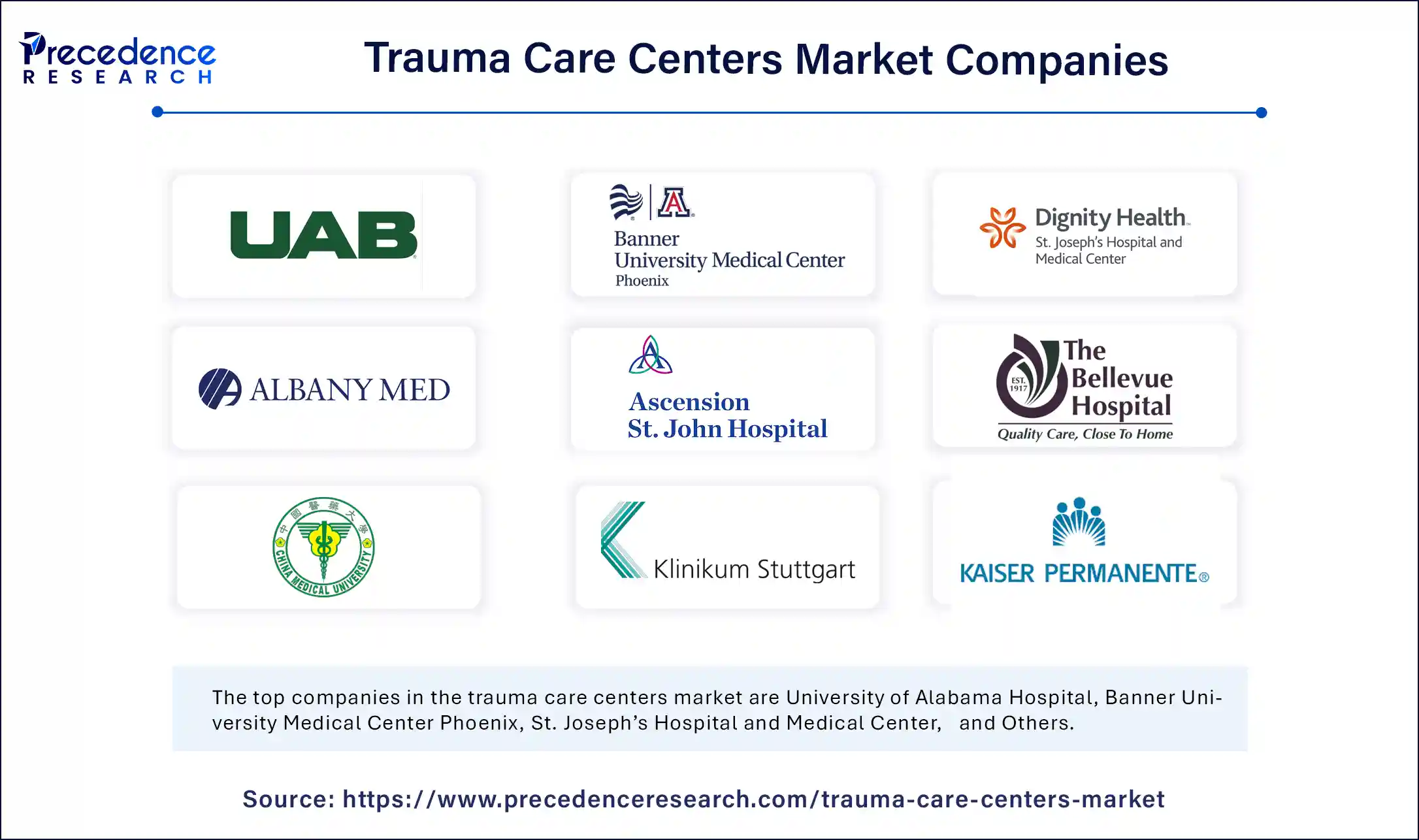
Trauma Care Centers Market Key Points
-
North America dominated the market with a 55% share in 2024.
-
Asia Pacific is projected to grow at a notable CAGR of 9% during the forecast period.
-
By facility type, the in-house segment held the highest share of 74% in 2024.
-
The standalone segment is expected to experience significant growth in the coming years.
-
By trauma type, the falls segment captured the largest share of 45% in 2024.
-
The traffic-related injuries segment is forecasted to grow at the fastest rate during the projection period.
-
By service type, the outpatient segment led the market with a 66% share in 2024.
-
The inpatient segment is anticipated to register the highest CAGR in the upcoming years.
Market Overview
The Trauma Care Centers Market plays a critical role in modern healthcare systems, focusing on providing rapid and specialized care for patients suffering from life-threatening injuries, including blunt force trauma, penetrating wounds, burns, traumatic brain injuries, and other emergencies. These centers are designed to deliver immediate surgical and medical intervention to stabilize patients and reduce mortality and morbidity rates. Trauma care centers are categorized into levels (I to IV) based on the depth of services offered, with Level I providing the most comprehensive care.
With the increasing incidence of road traffic accidents, violence-related injuries, industrial mishaps, and natural disasters, trauma centers are becoming indispensable components of emergency healthcare infrastructure. The growing emphasis on reducing preventable deaths and long-term disability has led to significant investments in trauma systems globally. In both developed and developing nations, governments and healthcare providers are expanding trauma care networks, upgrading facilities, and integrating advanced diagnostic and surgical technologies.
Growth Factors
Several important factors are driving the growth of the trauma care centers market. One of the key factors is the rising burden of trauma-related incidents, particularly due to road accidents, falls, sports injuries, and occupational hazards. According to WHO, injuries from such causes are among the leading contributors to global mortality, especially among people aged 5–44, thereby necessitating efficient trauma response systems.
Another major growth factor is increasing urbanization and industrialization, which correlates with a higher frequency of trauma cases due to construction accidents, traffic congestion, and high-speed transportation. With economic development, there is also more demand for efficient emergency medical services (EMS), including trauma units with 24/7 availability.
The expansion of healthcare infrastructure, especially in emerging markets, is contributing to market growth as governments invest in regional trauma centers to improve patient outcomes and reduce travel time during emergencies. Additionally, rising healthcare awareness and the promotion of timely trauma interventions are supporting growth, particularly through public health campaigns and training of first responders.
Advancements in trauma diagnostics, surgical tools, and rehabilitation therapies are also improving the efficiency and appeal of trauma care centers. Minimally invasive surgery, robotic assistance, and rapid imaging technologies are enhancing clinical outcomes and reducing recovery times.
Impact of AI on the Trauma Care Centers Market
Artificial Intelligence (AI) is significantly reshaping the trauma care landscape by enhancing the speed, precision, and efficiency of emergency medical response. One of the most profound impacts of AI in trauma care centers is in clinical decision support systems (CDSS). These tools assist healthcare providers in quickly diagnosing injuries, prioritizing treatment steps, and optimizing surgical planning, especially during golden-hour emergencies.
AI-driven predictive analytics is being used to anticipate complications such as sepsis, internal bleeding, or organ failure based on real-time vital signs, lab data, and imaging results. By alerting physicians to these risks in advance, AI helps reduce critical delays and improves patient survival rates.
In trauma triage, AI algorithms integrated with EMS systems can analyze incoming data from ambulances, including video feeds, vitals, and audio inputs, to prepare trauma teams before the patient even arrives. This real-time coordination ensures that the right specialists, surgical teams, and resources are mobilized in advance, reducing response time and increasing the chances of successful outcomes.
AI is also streamlining resource management and workflow optimization in trauma centers. Predictive tools help anticipate patient volumes and guide staffing, equipment readiness, and operating room availability. Furthermore, AI-powered imaging tools significantly reduce interpretation time of CT scans, MRIs, and X-rays, which is vital in assessing traumatic brain injuries or internal hemorrhage.
Lastly, in post-trauma care, AI supports rehabilitation monitoring, patient recovery tracking, and telemedicine, ensuring continuity of care and better long-term recovery outcomes.
Market Drivers
- Increasing incidence of trauma cases due to urbanization, motor vehicle accidents, violent crimes, and workplace injuries.
- Government funding and public health policies aimed at strengthening trauma systems, especially in rural and underserved areas.
- Growing demand for specialized and multidisciplinary emergency care, including neurosurgery, orthopedics, and intensive care.
- Technological innovations in imaging, surgical techniques, diagnostics, and patient monitoring that enhance trauma management efficiency.
- Development of integrated trauma networks that link EMS, hospitals, and rehabilitation centers for seamless care delivery.
Opportunities
- Expansion in emerging economies where trauma systems are still developing, offering vast potential for investment in new trauma centers, equipment, and training.
- Adoption of AI and teletrauma technologies that allow remote diagnosis and expert consultation during mass casualty incidents or in remote regions.
- Public-private partnerships (PPPs) in infrastructure development, especially in countries with limited healthcare spending but rising trauma rates.
- Increasing emphasis on rehabilitation and post-trauma care, leading to demand for integrated trauma and recovery centers.
- Use of data analytics and electronic health records (EHRs) to evaluate trauma outcomes, optimize care protocols, and reduce costs through evidence-based practices.
Challenges
- High capital investment and operational costs for setting up and maintaining Level I or Level II trauma centers, which often require round-the-clock staff, advanced equipment, and extensive space.
- Shortage of trained trauma specialists including trauma surgeons, emergency physicians, anesthetists, and critical care nurses, particularly in rural and low-income regions.
- Inconsistent regulatory frameworks and accreditation standards across regions, which impact quality assurance and interoperability of trauma systems.
- Underdeveloped pre-hospital care infrastructure in many developing countries, where EMS capabilities are limited or non-existent, affecting timely trauma response.
- Mental health and long-term care gaps, as many trauma survivors require psychological support and rehabilitation that is often underfunded or overlooked.
Market Scope
| Report Coverage | Details |
| Market Size by 2034 | USD 36.24 Billion |
| Market Size in 2025 | USD 18.74 Billion |
| Market Size in 2024 | USD 17.42 Billion |
| Market Growth Rate from 2025 to 2034 | CAGR of 7.60% |
| Dominating Region | North America |
| Fastest Growing Region | Asia Pacific |
| Base Year | 2024 |
| Forecast Period | 2025 to 2034 |
| Segments Covered | Facility Type, Trauma Type, Service Type and Region |
| Regions Covered | North America, Europe, Asia-Pacific, Latin America, and Middle East & Africa |
Regional Outlook
North America dominates the trauma care centers market due to its advanced healthcare infrastructure, comprehensive trauma systems, and high incidence of road accidents and violence-related injuries. The U.S., with its well-established network of Level I-IV trauma centers and strong funding support, continues to be a leader in trauma care innovation and policy development.
Europe holds a significant market share with countries like Germany, the UK, and France investing heavily in regional trauma networks, emergency preparedness, and integrated care delivery. The presence of universal healthcare in many EU countries also facilitates access to trauma services for broader populations.
Asia-Pacific is expected to witness the fastest growth, driven by rapid urbanization, increasing vehicle density, industrial expansion, and government-led health reforms in countries like China, India, and Southeast Asia. However, disparities in healthcare access and funding remain a challenge, creating opportunities for mobile trauma units and modular care solutions.
Latin America and the Middle East & Africa are emerging markets with growing demand for trauma care infrastructure. Conflict zones, traffic injuries, and natural disasters drive the need for specialized trauma centers. International aid, nonprofit initiatives, and telemedicine are beginning to bridge the healthcare gaps in these regions.
Trauma Care Centers Market Companies

- University of Alabama Hospital
- Banner University Medical Center Phoenix
- St. Joseph’s Hospital and Medical Center
- Albany Medical Center
- Ascension St. John Hospital
- Bellevue Hospital Center
- China Medical University Hospital
- Klinikum Stuttgart
- Kaiser Permanente
- University Hospital Southampton NHS Foundation Trust
Segments Covered in the Report
By Facility Type
- In-house
- Standalone
By Trauma Type
- Falls
- Traffic-related Injuries
- Stab/Wound/Cut
- Burn Injury
- Brain Injury
- Other Injuries
By Service Type
- Inpatient
- Outpatient
- Rehabilitation
By Region
- North America
- Europe
- Asia Pacific
- Latin America
- Middle East & Africa
Read Also: Immunoprotein Diagnostic Testing Market
Get this report to explore global market size, share, CAGR, and trends, featuring detailed segmental analysis and an insightful competitive landscape overview @ https://www.precedenceresearch.com/sample/6090
You can place an order or ask any questions, please feel free to contact at sales@precedenceresearch.com|+1 804 441 9344
- Arteriovenous Implants Market Enhance dialysis outcomes with advanced grafts, endovascular access, and AI-assisted precision - September 16, 2025
- Smart Retinal Implants Market Restore vision with wireless bioelectronic prosthetics and AI-powered retinal technologies - September 16, 2025
- Myopia Treatment Devices Market Size to Reach USD 38.51 Billion by 2034, Growing at a CAGR of 7.86% - September 1, 2025
